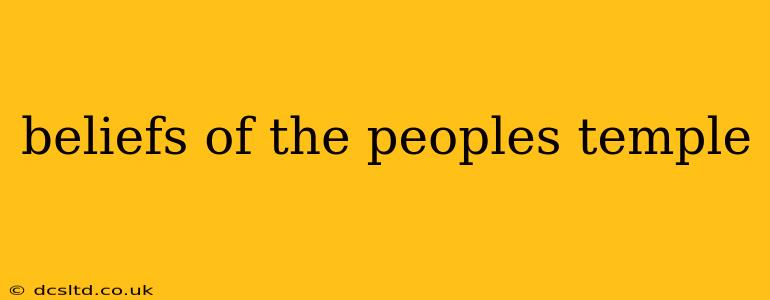The Peoples Temple, once a seemingly benevolent religious organization, ultimately became infamous for its tragic end at Jonestown, Guyana. Understanding its rise and fall requires a thorough examination of the beliefs that fueled its fervent following and ultimately led to its demise. While often simplified as a cult of personality around Jim Jones, the Peoples Temple's ideology was a complex blend of several interwoven belief systems. This exploration delves into the core tenets, examining how they evolved and contributed to the tragic events of November 18, 1978.
What were the core beliefs of the Peoples Temple?
At its inception, the Peoples Temple presented itself as a racially integrated, socially progressive Christian church focused on community service and social justice. This initial appeal resonated with many, particularly those marginalized within society. However, over time, Jones's teachings evolved, incorporating elements of various spiritual and political ideologies. Key beliefs included:
- Socialism and racial equality: Early on, the Temple championed racial harmony and social justice, attracting a diverse following committed to these ideals. Jones presented himself as a champion of the poor and oppressed.
- Charismatic leadership and faith healing: Jones cultivated an image as a divinely inspired leader capable of miraculous healing and prophecy. This fostered intense loyalty and dependence on him.
- "Revolutionary Suicide": This disturbing doctrine, developed over time, posited that death, even mass suicide, was preferable to living under the oppressive forces of the outside world. This belief became tragically central to the Jonestown Massacre.
- Syncretism of religious beliefs: The Temple’s beliefs weren't confined to traditional Christianity. Jones incorporated elements from other religions and philosophies, including Pentecostalism, Marxism, and even aspects of Eastern mysticism. This eclectic mix created a unique and often confusing belief system for followers.
- The "Father" figure of Jim Jones: The cult of personality surrounding Jones was paramount. He demanded absolute loyalty and obedience, often employing fear and manipulation to control his followers.
How did the Peoples Temple's beliefs change over time?
The Temple's ideology underwent a significant transformation as it relocated to California and eventually Guyana. The initial focus on social justice gradually shifted towards an increasingly authoritarian and apocalyptic worldview. Jones's control intensified, leading to a climate of fear and unquestioning obedience. The emphasis on community morphed into a system of complete dependence on Jones and his pronouncements. The early promise of racial equality ultimately became overshadowed by Jones's increasingly erratic and dictatorial control.
What role did Jim Jones play in shaping the Temple's beliefs?
Jim Jones was the central figure shaping the Temple's beliefs and practices. His charismatic personality and manipulative tactics were instrumental in fostering unquestioning loyalty among his followers. He gradually shifted the focus from social activism to a complete dependence on him as a divine leader. He used his power to control all aspects of his followers' lives, manipulating their thoughts, emotions, and actions.
What were the Peoples Temple's rituals and practices?
The Temple's rituals evolved alongside its beliefs. Initial practices were relatively conventional, with church services, community outreach, and social programs. However, as Jones's power grew, rituals became increasingly bizarre and controlling. These included:
- "White nights": All-night services characterized by intense emotional displays and the expectation of unquestioning obedience.
- "Love bombing": A technique used to recruit and indoctrinate new members, overwhelming them with affection and attention.
- "Faith healing" and "demonstrations of power": Jones claimed the ability to heal illnesses and perform miracles, further reinforcing his authority.
- Forced confessions and public criticism: Members were frequently subjected to public humiliation and self-criticism to maintain conformity.
How did the Peoples Temple's beliefs lead to the Jonestown Massacre?
The culmination of the Temple's beliefs and practices was the tragic Jonestown Massacre. The apocalyptic vision Jones cultivated, coupled with his absolute control and manipulation, created a climate ripe for mass suicide. The belief in "revolutionary suicide" as a preferable alternative to life outside the Temple's control directly resulted in the deaths of over 900 people, including hundreds of children.
The Peoples Temple’s story serves as a stark reminder of the dangers of charismatic leadership, unquestioning obedience, and the manipulation of religious beliefs. Understanding its history is crucial to preventing similar tragedies in the future. The complex interplay between social justice ideals, charismatic leadership, and apocalyptic beliefs provides valuable insight into the psychology of cults and the dangers of unchecked power.
